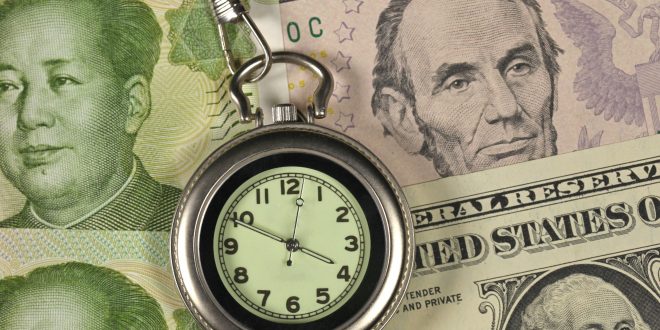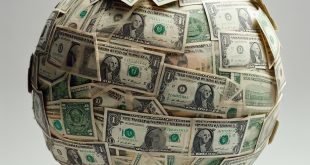The second week of April was highlighted by strong economic data that showed increased signs of a global recovery from the negative impacts of the coronavirus pandemic.
Such recovery signs helped improve risk appetite among investors, which reflected positively on many assets. On the other hand, rising tensions between the United States and both Russia and China helped raise the demand for safe havens, which also witnessed an improved demand due to hedging against an expected rise in inflation rates.
For example, Treasury bond yields in the United States rose on Friday due to selling pressure but logged a decline for the week that was the biggest in ten months, at around 10 basis points. Market expectations indicate a further decline in yields due to expectations of a rise in inflation, which Fed officials say would be temporary over next summer due to the large fiscal stimulus prompting increased consumer spending.
In the U.S., data by the Department of Commerce showed that retail sales surged by 9.8% in March, in the largest increase seen since May 2020.
Furthermore, data also showed an increase in industrial output last month, following a decline in February, which indicates a recovery in the manufacturing and mining industries, especially after a setback that resulted from bad weather conditions and a strong winter storm hitting southern parts of the U.S.
Accordingly, it was no surprise to see a decline in the applications for jobless claims, or unemployment benefits, last week by around 200,000, according to data by the U.S. Department of Labor.
the Consumer Price Index (CPI) in the United States registered last month its biggest increase since August 2012, adding 0.6%, and advanced by 1.6% on a monthly basis.
The substantial rise in inflation came shortly after the Chairman of the U.S. Federal Reserve, Jerome Powell, suggested in a TV interview aired on Sunday that he expects a temporary rise in consumer prices over the summer, reiterating that the monetary policymakers will be patient until they see inflation at 2%. The Fed will be tolerating a short-term spike above that level with the aim to reach an average stable 2% inflation rate.
Meanwhile, President of the Federal Reserve Bank of Philadelphia, Patrick Harker, suggested that the U.S. economy could grow by 5-6% in 2021, supported by a wider rollout of vaccines and reopening the economy.
In Europe, data by Eurostat indicated that inflation accelerated in the Eurozone, mainly driven by rising costs of services and energy.
The Eurozone consumer price index (CPI) rose by 0.9% on a monthly basis in March, registering an increase of 1.3% on an annual basis.
Dollar
The U.S. Dollar (USD) was negatively impacted by the decline in Treasury bond yields, falling against major currencies.
The Dollar Index (DXY), which measures the greenback’s performance against a basket of six major international currencies, fell for the week by about 0.67% as it finished the week at its lowest closing level since March 11.
This is the second consecutive weekly decline for the USD, as recent remarks by the Fed officials cementing their monetary policy stance did not provide support for the Dollar.
The Fed continues to indicate that it will not be raising interest rates anytime soon from their current low levels close to 0%, vowing to monitor the economic indicators and only start reducing the pace of its asset purchases before any interest rate hikes. A change in policy is unlikely to take place until the Fed sees substantial evidence that it has achieved its employment and inflation goals, allowing inflation to briefly run above the 2% target to reach the desired average.
Sterling
The British Pound (GBP) strongly rebounded on Friday, maintaining a positive performance that helped erase almost all of its losses from the week before.
By the end of the week, the Sterling Pound was at its best level since April 7, to enhance its best weekly gains since early February.
Demand for the GBP was driven by positive expectations for easing lockdowns and preventive measures across the UK and despite concerns about the side effects of some used vaccines.
For the week, the GBP/USD pair gained about 0.91%, as it finished near 1.3832.
Euro
Similarly, the Euro (EUR) continued the upward trend to finish the week at its highest level in about a month and recovering from the strong declines that it witnessed during the second half of last month.
The single European currency rose against the declining Dollar, with the EUR/USD pair gaining about 0.71% for the week.
A strong rise in inflation, which remains well below the target of the European Central Bank (ECB), provides support for the EUR, alongside positive economic data that signaled recovery.
ECB President Christine Lagarde recently said that the U.S. is more likely to achieve the 2% target for inflation rate before the European block, expecting better distribution of vaccine across Europe, compared with the recent slow rollout.
Gold
The yellow metal logged its largest weekly gain since the beginning of the year, supported by increased demand for safe havens and the decline in the U.S. Dollar (USD) and Treasury bond yields.
Gold futures for June delivery increased by 2%, registering its best weekly performance since December 18, as it closed at $1,780.20 per ounce, near its highest level since late February.
Some market analysts expect the large fiscal support and stimulus spending would help increase the demand for the yellow metal in the near future, especially as a hedging method against the expected rise in inflation.
Oil
Crude oil futures rose on every session this week except for the last one but managed to score their best weekly gains since the first week of March.
The global benchmark, Brent crude futures for June delivery finished the week at the level of $66.77 per barrel, registering a weekly rise of 6.1%.
Meanwhile, the West Texas Intermediate (WTI) crude futures for May delivery closed at $63.13 per barrel, rising by 6.4% for the week.
Gains by oil futures came mostly on the back of positive expectations for demand recovery by the Organization of the Petroleum Exporting Countries (OPEC) and the International Energy Agency (IEA).
Stocks
European stocks showed a positive record-breaking performance this week on the back of strong economic data and recovery signs.
The STOXX Europe 600 index rose by about 2.1% for the week to settle at a new all-time high of 442.20 points.
The pan-European index broke its record closing high in the last two sessions of the week.
Meanwhile, Wall Street also witnessed two consecutive new record-setting by two of its main indices.
The Dow Jones Industrial Average finished the week above 34,200 points, after exceeding the 34,000-point mark for the first time on Thursday, rising by 1.2% for the week.
The S&P 500 index finished at another record high at 4,185.5, gaining 1.4% on a weekly basis.
Meanwhile, the Nasdaq Composite Index, which ended the week at 14,052, increased by 1.1% for the week very close to its all-time record high.
Cryptocurrency
Bitcoin hit a new all-time high on Wednesday a little below $65,000. Although it retreated from this record high level.
The biggest cryptocurrency in the world in terms of market capitalization still maintained a weekly rise of about 5.7%, as it reached $61,705 by late Friday’s trade.
Similarly, the second-largest digital currency, Ethereum, hit a new record high on Thursday a little below $2,500, to finish the week near $2,433 with gains of more than 17%.
In other major crypto news, the Cryptocurrency exchange Coinbase Global Inc. witnessed a strong debut on Wall Street, on which it began trading through a direct listing with a conventional initial public offering (IPO).
 Noor Trends News, Technical Analysis, Educational Tools and Recommendations
Noor Trends News, Technical Analysis, Educational Tools and Recommendations





